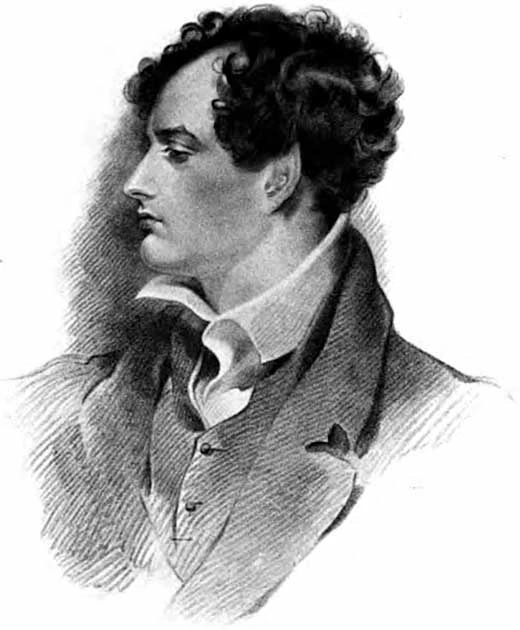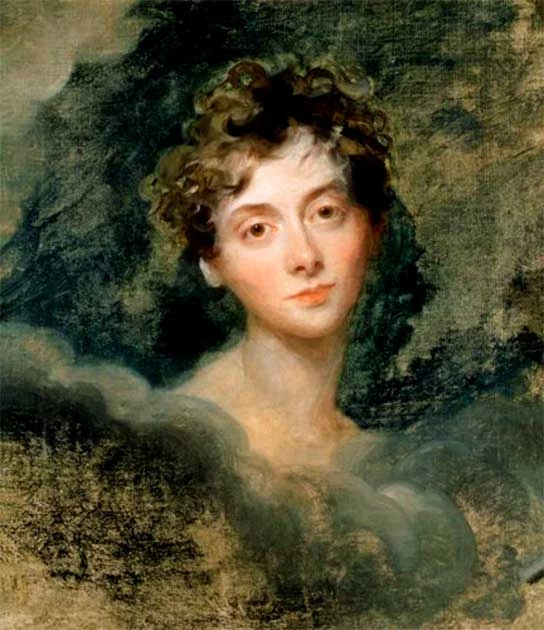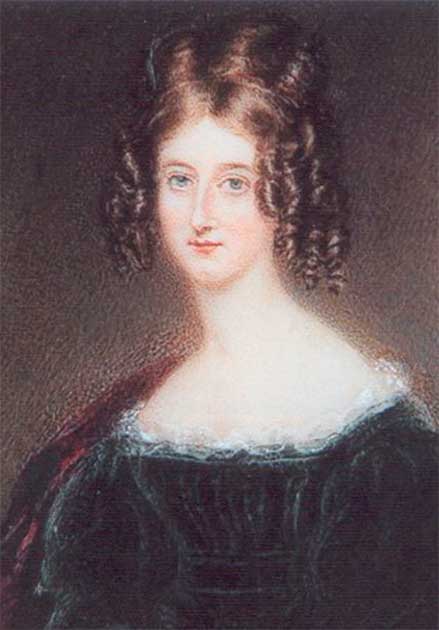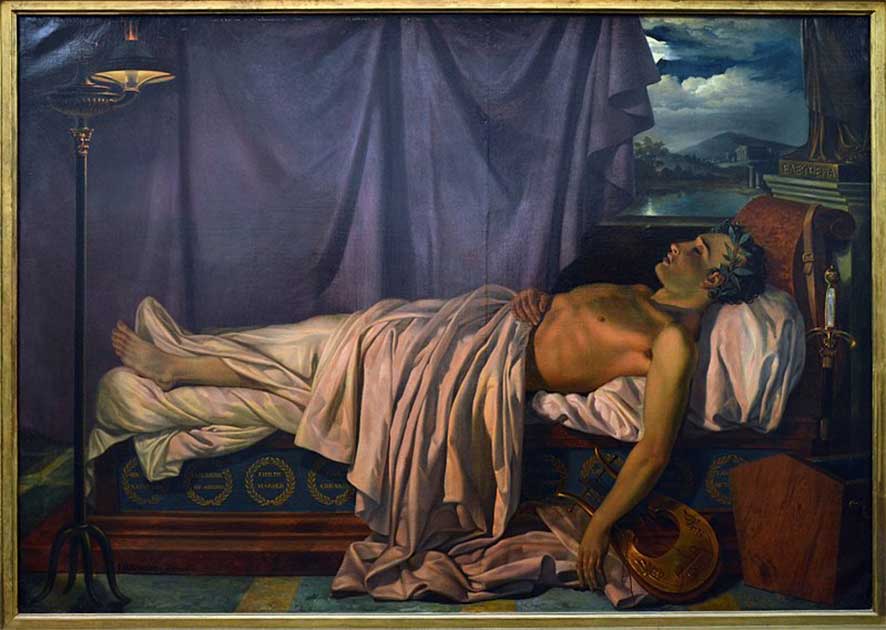One of the most widespread cultural taboos is incest: sexual activity between family members or close relatives. The umbrella of incest includes sexual relations between people in consanguinity (blood relative) and sometimes by affinity (marriage/stepfamily).
The act itself is seen as immoral in most societies, and incest can increase a child’s chances of developing genetic disorders from inbreeding. Most major religions speak against incest, and incest is illegal in most countries.
This taboo act is also perhaps the most taboo of all rumors surrounding the notorious English poet Lord Byron. Did he have an incestuous affair with his married sister? Or was this a rumor perpetuated by a jealous and vengeful former lover?
Lord Byron and the Byronic Hero
George Gordon Byron, 6th Baron Byron of Rochdale, known simply as Lord Byron, was born on January 22, 1788, in London, England. Lord Byron was an English romantic poet. He is considered to be one of the leading figures of Romanticism (Romantic movement, Romantic era).
Romanticism was an intellectual, musical, artistic, and literary movement that developed in Europe at the end of the 18th century. The “peak romantic period” was from 1800 to 1850. Romanticism was emphasized by “intense emotions as an authentic source of aesthetic experience, placing new emphasis on such emotions as fear, horror, terror, and awe – especially that experienced in confronting the new aesthetic categories of the sublime and beauty of nature.”

Some additional English poets from the romantic period are William Wordsworth, John Keats, Percy and Marry Shelley, and William Blake. Lord Byron is regarded today as one of England’s greatest poets.
Lord Byron was responsible for penning the well-known works of Don Juan, The Corsaire, Prometheus, and Manfred. Along with being a notable poet, Lord Byron was also a politician; the Lord in front of his name wasn’t just for show. Lord Byron was a member of the House of Lords, the upper house of the Parliament of the United Kingdom, from 1809 until his death in 1824.
Lord Byron developed a literary character archetype known as the Byronic Hero, perhaps best glossed as a more extreme variant of the Romantic hero. Byronic heroes are the protagonists who tend to reject traditional social values.
The characteristics of a Byronic hero, whom Lord Byron based on himself, are charisma, arrogance, brooding, intelligence, emotional or intellectual tortured, mystery, perception, and sexually liberation. From henceforth such a hero would become a mainstay of fiction.
The Brontes loved this archtype and the Byronic in both Mr Rochester from Jane Eyre and especially Heathcliff from Wuthering Heights are plain. Looking further afield, you may find him in Jay Gatsby from The Great Gatsby by F Scott Fitzgerald, or in almost any depiction of a vampire.
Sexual Liberation
Lord Byron’s love life was for most of his life central to his existence. Five different women are said to have been Byron’s lovers, there are likely many more, and many historians believe Lord Byron was also bisexual.
Regardless of his sexuality, the love life of Lord Byron was a mess, and when he fled England in 1816, wild rumors began to spread. Including allegations of incest and sodomy (homosexuality was considered a crime during this period of English history).
In his journals, Lord Byron wrote about his intense attraction to his cousin Mary Duff when he was seven years old. Lord Byron was puzzled by his attraction to both Mary and another cousin.
In his journal, Lord Byron wrote, “And it is a phenomenon in my existence (for I was not eight years old) which has puzzled, and will puzzle me to the latest hour of it; and lately, I know not why, the recollection (not the attachment) has recurred as forcibly as ever…But, the more I reflect, the more I am bewildered to assign any cause for this precocity of affection.”

But the gossip went elsewhere in 1812. Lord Byron was in a highly publicized affair with the married Lady Caroline Lamb, an affair which is said to have shocked the British public. After Lord Byron ended his affair, Lady Caroline described him as “mad, bad, and dangerous to know.”
Perhaps she was upset about being dumped? Or maybe it had something to do with the fact that upon breaking up, Lord Byron pursued and married her cousin, Anne Isabella Milbanke, who became Lady Byron in 1815.
Lord and Lady Byron gave birth to their child Ada Lovelace in 1816, but not long after the birth of Ada, Lady Byron left Lord Byron and took Ada with her. Rumors began to swirl about the Byrons and how Lord Byron was violent, had affairs with actresses, engaged in sodomy, and was involved in an incestuous relationship with his half-sister.
These claims were strongly supported by his former lover Lady Caroline, who was said to have been incredibly jealous of Lady Byron’s marriage. So were the claims of incest valid or just rumors spread by a scorned lover?
Augusta Maria
But what caused Lord Byron to flee the country in 1816? Byron had become close, possibly too close, with his half-sister Augusta Maria Leigh (née Byron). August was the daughter of Lord Byron’s father and his first wife, and the two were not raised together.
The half-siblings met for the first time when Lord Byron was a student at the Harrow School in London, England. Lord Byron and his half-sister Augusta Maria wrote letters to each other regularly, and Augusta was one of Lord Byron’s closest confidantes.
It is unknown if the claims of incest between the two were true, but many cite the birth of Augusta’s third daughter as proof. Augusta married her cousin, Lt. Colonel George Leigh, and went on to have seven children with her husband.
In the spring of 1814, Augusta gave birth to her third child, Elizabeth Medora Leigh. A few days after the birth, Lord Byron visited his half-sister to meet the baby.
He wrote in a letter to a friend, “Oh! But it is ‘worth while’, I can’t tell you why, and it is not an ‘Ape’, and if it is that must be my fault; however I will positively reform. You must however allow that is utterly impossible I can ever be have so well lie else-where, and I have been all my life trying to make someone love me and never got the sport I preferred before.”
- The Witch-Queen of England? Revisiting Anne Boleyn’s Guilt
- Does the Marquis de Sade Deserve his Sordid Reputation?
Going to visit his half-sister, who was his close friend and correspondent, to meet the new baby is not odd, nor is it an indication that Lord Byron fathered the baby Elizabeth. What he wrote in the letter mentioned above is very ambiguous. At no point does Lord Byron write, “I had an incestual relationship with my half-sister, and she gave birth to my child.”
Many note that Elizabeth’s middle name, Medora, is the name of the wife of one of the protagonists in Byron’s The Corsair. If Medora was chosen to honor her birth father or was just a name from her half-brother’s book that Augusta liked is a mystery.

When the claims about Lord Byron’s incestual relationship with his half-sister Augusta came to light, it was after Lady Byron had left him. We know Lady Caroline was bitter that Lord Byron married her cousin and broke up with her (a married woman), and hell hath no fury like a woman scorned.
Lady Caroline may have been more than happy to repeat claims of incest when speaking of her former flame. It has not been confirmed nor denied that there was an incestuous relationship between Lord Byron and his half-sister.
Legality
The case becomes thornier still. At the time when Lord Byron was alive, incest was not illegal. The nobility have been well known for marrying siblings or first cousins to produce an heir and preserve the royal bloodline/keep royal titles within the family: Augusta own wedding, as noted above, was to her cousin.
Incest was not made illegal in England and Wales until the Punishment of Incest Act of 1908 was created. This Act prohibited a man in England or Wales from engaging in sexual intercourse with any female “he knew to be his grand-daughter, daughter, sister, half-sister, or mom.” Until the Punishment of Incest Act of 1908 was created, incest was seen as an ecclesiastical offense in which the punishment for such an act was penance.
If Lord Byron did, in fact, have an incestuous affair with his half-sister, it wasn’t considered a crime. Is it considered wrong today? Absolutely. But it would be another 84 years before incest was made illegal in England.
Lord Byron fled England not long after Lady Byron left him due to threats of being lynched. He spent time in Italy with Percy and Mary Shelley and became a soldier in the Greek War of Independence against the Ottoman Empire.

Why Byron joined the Greek War of Independence is unknown, but it would be the end of him. He died leading a campaign from an illness or fever. Lord Byron was, and still is regarded as a folk hero by the Greeks.
A Strange Collection and a Strange Man
Lord Byron was known for having affairs with women (sometimes married women), and it is believed he had experiences with men during his life. He was an English Casanova of sorts and made no effort to keep his private life private.
It isn’t surprising to learn that Lord Byron liked to save mementos from his lovers. Giving a lover a lock of hair was seen as a romantic gesture, but Lord Byron decided that hair from the head was no good. He would cut off clumps of his lover’s pubic hair which he then labeled and placed the hair in an envelope, cataloged the souvenir, and add it to his collection of pubic hairs, which was stored at his publishing house for some odd reason.
The idea that Lord Byron had an incestuous relationship with his half-sister who bore his child is up there with the debate about Lord Byron’s sexuality. Interestingly, pieces of writing and Lord Byron’s history can be used to support an opinion, but that is all that can come from this. When Lord Byron died in 1824, he took the truth to the grave.
Top Image: George Gordon, Lord Byron. Source: Thomas Phillips / Public Domain.